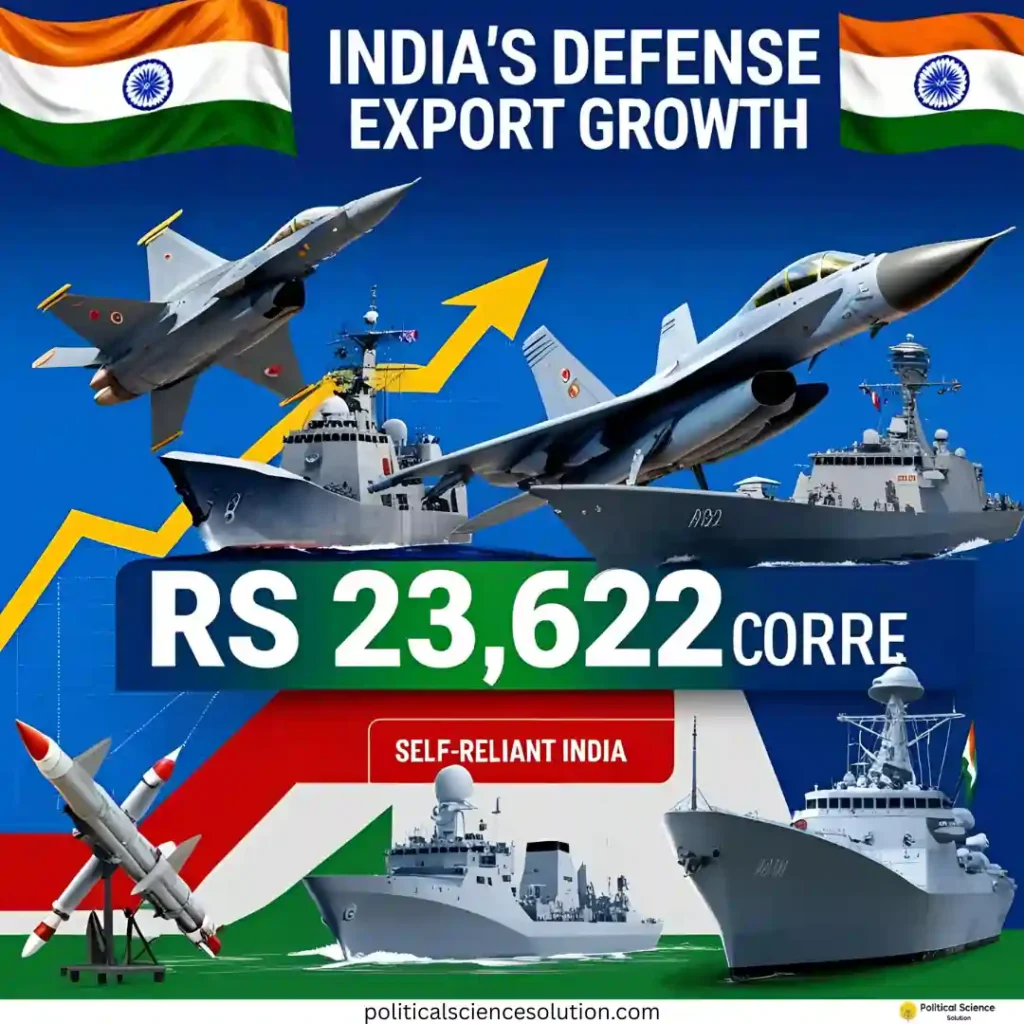New Delhi: In a landmark achievement for India’s defence sector, the country’s defence exports reached an unprecedented Rs 23,622 crore (approximately USD 2.76 billion) in the financial year 2024-25. This figure reflects a robust 12.04% growth over the previous fiscal year’s Rs 21,083 crore, signaling India’s rising prominence in the global defence market. Announced by Defence Minister Rajnath Singh on April 1, 2025, this milestone underscores the nation’s strides toward self-reliance and its ambition to become a key player in the international defence supply chain. With Prime Minister Narendra Modi calling it a “proud milestone,” the achievement has sparked widespread optimism about India’s future in defence manufacturing.

A Surge in Defence Exports: Breaking Down the Numbers
India’s defence exports for 2024-25 stood at Rs 23,622 crore, a jump of Rs 2,539 crore from the Rs 21,083 crore recorded in 2023-24. This 12.04% year-on-year increase highlights the growing demand for Indian-made defence products worldwide. The private sector led the charge, contributing Rs 15,233 crore (64% of the total), while Defence Public Sector Undertakings (DPSUs) accounted for Rs 8,389 crore. Notably, DPSUs registered an impressive 42.85% growth in their exports, up from Rs 5,874 crore the previous year, reflecting their increasing competitiveness.
The export portfolio has diversified significantly, encompassing items like 155 mm artillery shells, small arms, bulletproof jackets, Dornier (Do-228) aircraft, Chetak helicopters, and critical subsystems. These products reached approximately 80 countries, with major importers including the United States, Israel, and Germany. This global reach demonstrates India’s ability to cater to varied defence needs, from ammunition to advanced aircraft, reducing its historical reliance on imports.
The Road to Self-Reliance: A Decade of Transformation
India’s journey from an import-dependent military power to an emerging defence exporter is a testament to a decade of policy reforms and industrial growth. Between 2014-15 and 2023-24, domestic defence production surged by 174%, laying the foundation for export growth. The Modi government’s “Make in India” initiative has been pivotal, encouraging indigenous manufacturing and reducing dependency on foreign suppliers.
In 2024-25 alone, 92% of global contracts signed by the Ministry of Defence were awarded to domestic industries, a clear indicator of trust in Indian capabilities. The private sector’s Rs 15,233 crore contribution underscores its growing role, bolstered by simplified licensing and export processes. Meanwhile, DPSUs, despite lagging behind in absolute production, have shown remarkable improvement, aligning with the government’s vision of a self-reliant defence ecosystem.
Prime Minister Modi emphasized this shift on social media, stating, “This is indeed a proud milestone in our journey towards self-reliance and global leadership in defence manufacturing!” His words reflect a broader national narrative: India is no longer just a buyer but a builder and seller of military hardware.
Policy Reforms Fueling the Boom
The record-breaking export figures are no accident—they stem from deliberate policy interventions. The Department of Defence Production’s dedicated online portal has streamlined export authorizations, issuing 1,762 licences in 2024-25 compared to 1,507 the previous year—a 16.92% increase. The number of exporters also grew by 17.4%, reflecting a widening industry base.
Key reforms include simplifying industrial licensing, removing parts and components from licensing requirements, and extending licence validity periods. In the last financial year, the Standard Operating Procedure (SOP) for export authorizations was further refined, cutting bureaucratic red tape and boosting efficiency. These measures have made it easier for both private firms and DPSUs to tap into international markets, aligning with the government’s target of Rs 3 lakh crore in defence production and Rs 50,000 crore in exports by 2029.
Defence Minister Rajnath Singh, speaking on April 1, 2025, expressed confidence in meeting these goals. “Under PM Narendra Modi’s leadership, India is marching towards achieving the target of increasing defence exports to Rs 50,000 crore by 2029,” he said, congratulating stakeholders for their role in this “significant achievement.”
Key Drivers of Success
Several factors have propelled India’s defence exports to this historic high:
- Global Conflicts and Demand: The Russia-Ukraine war and Israel-Hamas conflict have heightened global demand for defence equipment, with countries seeking reliable suppliers. India’s timely production of 155 mm shells and artillery guns has filled this gap, boosting exports.
- Diversified Portfolio: From small arms to advanced aircraft like the Dornier Do-228, India’s offerings cater to a wide range of needs, enhancing its appeal.
- Private Sector Dynamism: With Rs 15,233 crore in exports, private companies have outpaced DPSUs, leveraging innovation and agility to secure international contracts.
- DPSU Resilience: Despite challenges, DPSUs’ 42.85% export growth signals their ability to adapt and compete globally.
These drivers, combined with government support, have positioned India as a credible alternative to traditional defence exporters.
Challenges on the Horizon
Despite the optimism, India’s defence export journey faces hurdles:
- Technological Gaps: While exports have grown, India still imports critical components and raw materials due to a lack of technological depth in designing and manufacturing major systems. Bridging this gap is essential for sustained growth.
- DPSU Underperformance: Although DPSUs have improved, their Rs 8,389 crore contribution pales compared to the private sector’s Rs 15,233 crore. Boosting their production capacity remains a priority.
- Bureaucratic Delays: The lag between policy announcements and implementation, often due to red tape, continues to hinder progress.
Addressing these challenges will be crucial as India aims to scale exports to Rs 30,000 crore in 2025-26 and Rs 50,000 crore by 2029.
A Vision for the Future
India’s defence export surge is more than a financial milestone—it’s a strategic leap. The government’s earlier target of Rs 35,000 crore in exports by 2025, set in 2020, now seems within reach, with plans to achieve a Rs 1.75 lakh crore turnover in defence manufacturing. Rajnath Singh has already set a new interim goal of Rs 30,000 crore for 2025-26, reflecting confidence in the sector’s momentum.
The export growth also aligns with India’s geopolitical ambitions. By supplying defence equipment to 80 countries, India strengthens diplomatic ties and enhances its soft power. The US, Israel, and Germany’s emergence as top importers underscores India’s ability to meet the needs of advanced militaries, paving the way for deeper defence collaborations.
Conclusion: A New Era for Indian Defence
India’s record defence exports of Rs 23,622 crore in 2024-25 mark a turning point in its quest for self-reliance and global leadership. With a 12.04% growth rate, a diversified export portfolio, and robust policy support, the nation is on track to meet its ambitious targets. However, overcoming technological and bureaucratic challenges will be key to sustaining this trajectory.
As Rajnath Singh and Narendra Modi celebrate this achievement, the message is clear: India’s defence industry is no longer an underdog but a rising force. For businesses, policymakers, and citizens alike, this milestone offers a glimpse into a future where “Made in India” defence products dominate the world stage.
FAQs
1. What is the significance of India’s defence exports reaching Rs 23,622 crore in 2024-25?
India’s defence exports hitting Rs 23,622 crore in 2024-25 marks a historic milestone, reflecting a 12.04% growth from Rs 21,083 crore in 2023-24. This achievement highlights India’s growing role in the global defence market, its shift toward self-reliance, and the success of the “Make in India” initiative. It also positions India as a reliable supplier to around 80 countries, boosting its economic and strategic influence.
2. Which sectors contributed to India’s record defence exports in 2024-25?
The private sector and Defence Public Sector Undertakings (DPSUs) were the key contributors. The private sector led with Rs 15,233 crore (64% of the total), while DPSUs contributed Rs 8,389 crore, showing a remarkable 42.85% growth from Rs 5,874 crore in 2023-24. Products like artillery shells, bulletproof jackets, Dornier aircraft, and Chetak helicopters drove this export surge.
3. What are India’s future targets for defence exports?
India aims to achieve Rs 50,000 crore in defence exports by 2029, as stated by Defence Minister Rajnath Singh. An interim target of Rs 30,000 crore has been set for 2025-26. These goals align with a broader vision of Rs 3 lakh crore in defence production by 2029, reflecting the government’s ambition to make India a global defence manufacturing hub.
4. What challenges does India face in scaling its defence exports?
Despite the growth, India faces hurdles like a lack of technological depth, requiring imports of critical components, and slower production by DPSUs compared to the private sector. Bureaucratic delays between policy announcements and implementation also pose challenges. Overcoming these is essential to sustain the export momentum and meet future targets.
5. How have policy reforms supported India’s defence export growth in 2024-25?
Policy reforms such as simplified industrial licensing, a dedicated export authorization portal, and streamlined Standard Operating Procedures (SOPs) have been crucial. In 2024-25, 1,762 export licences were issued (up 16.92% from 1,507 in 2023-24), and the number of exporters grew by 17.4%. These measures have enhanced efficiency and encouraged both private firms and DPSUs to expand globally.

